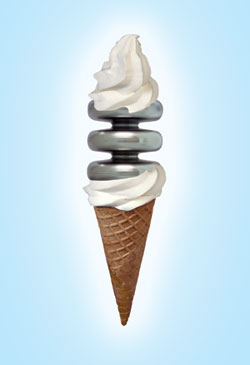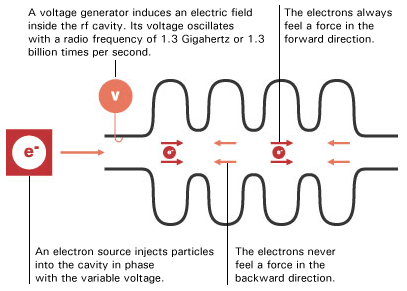Sold on cold
by Judith Jackson
Particle physics has chosen low-temperature superconducting technology for the International Linear Collider. What is "cold," and why have particle physicists lowered the temperature on a new accelerator?
 |
One hot day in August, particle physicists turned cold. That's the day the International Technology Recommendation Panel (ITRP) announced the decision to pursue "cold" superconducting technology for what physicists hope will be the world's next big particle accelerator, the International Linear Collider. Going cold, instead of recommending a "warm" option that had also been under development, has far-reaching consequences for laboratories, scientists, industries and governments across the globe. What does "cold" mean, and why did particle physics choose superconducting technology?
The technology for the ILC is called cold because it is cold—really, really cold, as in very close to absolute zero, as cold as you can get. That's the temperature at which low-temperature superconductors work their special magic, conducting electric current with no loss of energy. That means that in a superconducting accelerator, almost all the electrical energy goes into accelerating the beam, rather than into heating up the accelerating structures themselves. Since electricity is a major chunk of the cost of running a particle accelerator, the energy savings from superconductors endear them to accelerator builders. Of course, chilling down to near zero has a price, but the bottom line on operating costs still comes out ahead.
Filling cavities
The accelerator builder uses a voltage generator to fill a hollow structure called a cavity with an electric field. The voltage of the field changes with a certain frequency—a radio frequency, or rf. Charged particles feel the force of the electric field and accelerate. Build the cavity of superconductor and chill it to near zero and voilà: a "superconducting rf cavity." String enough of these cavities together, and you have a particle accelerator. That's cold technology.
Why cold? There are less chilly ways of accelerating particles. The ITRP offered several reasons for its choice. First, there are those energy savings. Over the long lifetime of a particle accelerator, they definitely add up. But there are other advantages too:
- Superconducting cavities have a relatively large opening for the beam to pass through. Sending particles through a large opening rather than a small one makes the beam less sensitive to ground motion and may permit a more powerful beam.
- Cold technology has applications beyond the ILC. Other accelerators are using it, or are about to use it, too. The CEBAF accelerator at Jefferson Laboratory in Virginia and the Spallation Neutron Source at Oak Ridge in Tennessee both use superconducting rf. The Department of Energy's proposed Radioactive Isotope Accelerator will go cold. And at Germany's DESY laboratory, where scientists pioneered the development of cold technology, physicists building a new superconducting light source will develop ILC-type cavities and test them in operation.
- The risk factor—can cavities be built at a reasonable cost in a reasonable time and will they work?—is lower for cold rf systems than for warm.
- Industrialization of most of the major pieces of a cold accelerator has already begun.
We're all cold together
Although scientists from laboratories in the United States and Asia made contributions, the TESLA collaboration at Germany's DESY led the way in developing high-gradient (lots of acceleration per meter) superconducting rf cavities. Japan's KEK laboratory and the Stanford Linear Accelerator Center concentrated on the warm alternative. Now that the technology choice is made, physicists from across the globe will join together to design—and, they hope, to build—the new cold accelerator.
"I am proud of the work that TESLA has done to bring superconducting rf technology to this point," said DESY Director Albrecht Wagner. "Now it is time for a new collaboration of the most talented and experienced scientists and engineers from the world's laboratories and universities to take cold technology to the next stage and to design the ILC. Success will require a level of international collaboration beyond anything that even particle physics has seen before."
Indeed, US laboratories including SLAC, Fermilab, Brookhaven, Cornell, Jefferson, Berkeley and Lawrence Livermore, in close partnership with Asian and European collaborators, have already begun to organize for continued R&D and to start the design of the new accelerator.
"This [cold] recommendation is made with the understanding that we are recommending a technology, not a design," the ITRP's report emphasized. "We expect the final design to be developed by a team drawn from the combined warm and cold linear collider communities, taking full advantage of the experience and expertise of both."
The particle physics community is now forming a global design team, to be located in a single location with an international director, to lead and orchestrate the many national and regional contributions that will add up to a design for a truly global new accelerator. When it comes to linear colliders, cold is the new hot.
 Superconducting rf cavity Superconducting rf cavityEach ILC cavity will have nine cells. The shape, size and geometry of cells and cavities optimize the electric field. Cavities are made of super- conducting niobium which conducts electricity without loss of energy. |
Click here to download the pdf version of this article.






